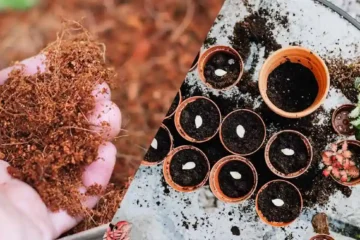Cocopeat, also known as coir pith, coir dust, or coir fiber pith, is a natural, renewable by-product derived from the processing of coconut husks. Widely recognized for its versatility and eco-friendly nature, cocopeat has gained substantial popularity among gardeners, horticulturists, and agricultural professionals. This article delves into the myriad benefits of cocopeat, emphasizing its importance in modern gardening and agricultural practices.
What is Cocopeat?
Cocopeat is made from the fibrous husk of the coconut, which is typically discarded during coconut processing. The material is ground into a fine powder and compressed into blocks or bricks for easy handling and transportation. Before use, cocopeat bricks are soaked in water to expand them into a loose, soil-like medium.
Benefits of Cocopeat
1. Sustainability and Environmental Friendliness
Cocopeat is a sustainable and eco-friendly product. Unlike peat moss, which is harvested from slowly regenerating peat bogs, cocopeat is a by-product of the coconut industry, making it a renewable resource. Using cocopeat helps reduce the waste from coconut processing and decreases the demand for non-renewable resources like peat moss.
2. Excellent Water Retention
One of the most significant benefits of cocopeat is its high water retention capacity. Cocopeat can retain up to eight times its weight in water. This property is particularly beneficial in regions with limited water availability, as it ensures that plants have a steady supply of moisture. Gardeners and farmers can water their plants less frequently, saving both time and water.
3. Aeration and Drainage
While cocopeat retains water effectively, it also provides excellent aeration and drainage. The fibrous structure of cocopeat allows for adequate air circulation around the roots, preventing waterlogging and root rot. This balance between water retention and drainage creates an ideal growing environment for a wide variety of plants.
4. Nutrient Holding Capacity
Cocopeat has a high cation exchange capacity (CEC), which means it can retain and release nutrients efficiently. This property ensures that essential nutrients are available to plants for a longer period. Cocopeat can hold onto nutrients supplied through fertilizers, reducing the need for frequent fertilization and enhancing plant growth.
5. pH Neutral
Cocopeat has a neutral pH range of 5.5 to 6.5, making it suitable for a wide range of plants. This neutrality allows gardeners to use cocopeat as a growing medium without worrying about pH imbalances that could affect plant health.
6. Pest and Disease Resistance
Cocopeat is naturally resistant to pests and diseases, which helps in reducing the need for chemical pesticides. Its structure does not provide an ideal environment for many soil-borne pathogens, promoting healthier plant growth and reducing crop losses.
7. Lightweight and Easy to Handle
Cocopeat is lightweight compared to traditional soil. This characteristic makes it easier to handle, transport, and work with, especially for indoor gardening and container planting. The ease of use is a significant advantage for urban gardeners and those with limited physical strength.
Applications of Cocopeat
1. Seed Starting
Cocopeat is an excellent medium for seed starting due to its fine texture and water retention properties. It provides a stable environment for seeds to germinate, ensuring that they receive adequate moisture and aeration. The use of cocopeat in seed starting trays can lead to higher germination rates and healthier seedlings.
2. Soil Amendment
Cocopeat can be used as a soil amendment to improve the physical properties of garden soil. Mixing cocopeat with existing soil can enhance its structure, increase its water retention capacity, and improve aeration. This is particularly beneficial for sandy soils that drain too quickly or clay soils that retain too much water.
3. Hydroponics
In hydroponic systems, cocopeat serves as an inert growing medium that supports plant roots while providing excellent water and nutrient retention. Its use in hydroponics has gained popularity because it is sterile, free of weeds, and easy to work with. Additionally, cocopeat’s ability to retain moisture reduces the frequency of irrigation in hydroponic setups.
4. Mulching
Cocopeat can be used as a mulch to cover the soil around plants. As a mulch, it helps retain soil moisture, suppress weeds, and regulate soil temperature. Over time, cocopeat mulch decomposes and adds organic matter to the soil, further enhancing soil fertility.
5. Container Gardening
For those involved in container gardening, cocopeat offers an ideal growing medium. Its lightweight nature makes it perfect for use in pots and planters, reducing the overall weight of containers and making them easier to move. The water retention and drainage properties of cocopeat also ensure that container plants thrive.
Economic Benefits
1. Cost-Effectiveness
Cocopeat is often more cost-effective than other growing media like peat moss or perlite. Given its renewable nature and widespread availability, cocopeat provides an economical option for large-scale agricultural operations and small home gardens alike.
2. Reduced Fertilizer Costs
Because of its high nutrient holding capacity, cocopeat reduces the need for frequent fertilization. This reduction translates into cost savings for gardeners and farmers, as they spend less on fertilizers over time. The efficient use of nutrients also means healthier plants with potentially higher yields.
3. Decreased Water Usage
The water retention properties of cocopeat lead to decreased water usage in gardening and farming. This benefit is especially crucial in arid regions where water is scarce and expensive. Lower water usage reduces irrigation costs and conserves a vital resource.
Environmental Impact
1. Reduced Carbon Footprint
The use of cocopeat helps reduce the carbon footprint associated with gardening and agriculture. By substituting peat moss, which is harvested from carbon-rich peat bogs, with cocopeat, gardeners and farmers contribute to the conservation of these important carbon sinks. Additionally, using a by-product of the coconut industry minimizes waste and promotes sustainability.
2. Waste Reduction
Utilizing cocopeat converts what would otherwise be waste into a valuable resource. The coconut industry generates significant amounts of husk waste, and turning this by-product into a growing medium helps mitigate the environmental impact of waste disposal.
Challenges and Considerations
1. Salt Content
Cocopeat can contain high levels of salts, which can be detrimental to plant growth. It is essential to rinse cocopeat thoroughly before use to remove excess salts. Many commercially available cocopeat products are pre-washed to address this issue.
2. Decomposition Rate
While cocopeat is generally slow to decompose, its rate of decomposition can vary based on the quality and processing methods. It is essential to source high-quality cocopeat to ensure its longevity as a growing medium.
3. Consistency
The consistency and quality of cocopeat can vary between suppliers. It is crucial to purchase cocopeat from reputable sources to ensure that it meets the necessary standards for gardening and agricultural use.
Conclusion
Cocopeat offers numerous benefits that make it an invaluable asset in gardening and agriculture. Its sustainability, excellent water retention, aeration properties, and nutrient holding capacity make it a versatile and eco-friendly choice for various applications. As the world increasingly moves towards sustainable and environmentally conscious practices, cocopeat stands out as a growing medium that not only enhances plant growth but also contributes to the conservation of natural resources. By understanding and utilizing the benefits of cocopeat, gardeners and farmers can achieve healthier plants, higher yields, and a more sustainable future.


